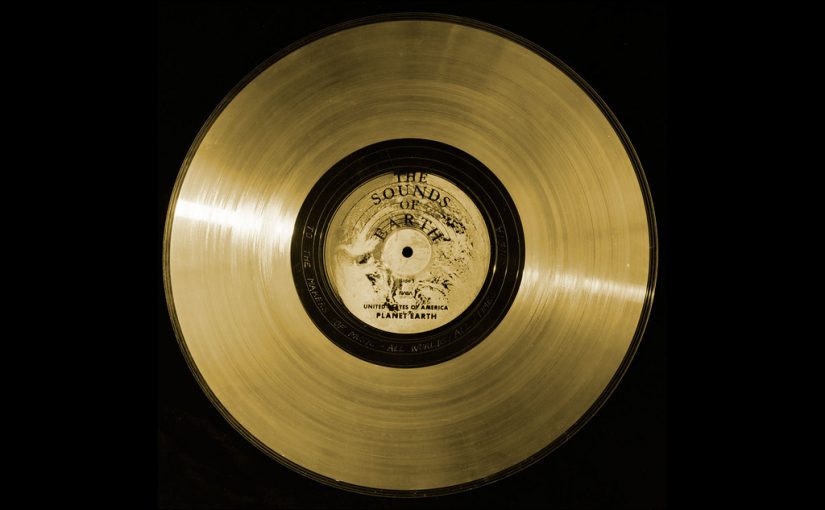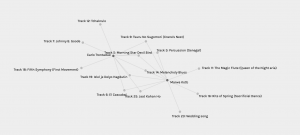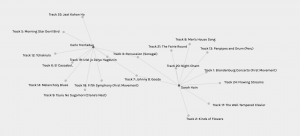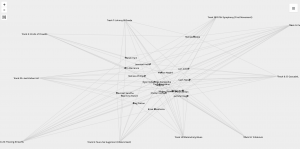Among the abundance of compelling tasks we were meant to complete throughout ETEC540, there remains a small collection that stood out as most intriguing; one being the Voyager Golden Record and the process of curating a sample of 10 tracks. As simple as this venture sounds, it challenges participants to address, as Abby Smith Rumsey suggests, what we afford to lose?.
It is a challenging question, because as Smith Rumsey asserts, it’s difficult to determine what has future value particularly due to our ineptitude with respect to predicting what contexts or events could eventually lend meaning. It’s not feasible to truly know the value of anything until far in the future when certain events and contexts provide meaning to seemingly ‘useless’ artifacts (Smith Rumsey, 2017). It then follows to reason that the best way we can form present value at least, in the context of potentially submitting ten songs from earth to our extraterrestrial brothers and sisters is to formulate some semblance of criteria to follow.
In foraging through my colleagues’ webspaces, I attempted to explore the criteria that others used to ascertain what tracks best belonged on their curated Golden Record. The network analytics I did on the Golden Record Curation Task revealed that Marwa and I chose 70% of the same songs, while Sarah H and I shared only 20% of the same songs. Thus, I decided to investigate the criteria they used for content selection.
Firstly, let’s review the selection criteria I adopted. I chose to use a specific tenet from Abby Smith Rumsey’s article Why Digitize as the foundation of my criteria:
“Creation of a ‘virtual collection” through the flexible integration and synthesis of a variety of formats, or of related materials scattered among many locations (Smith, 1999).
In essence, I creatively applied Smith Rumsey’s principles for valuable digital captures to the Golden Record curation exercise. It’s worth noting that this record is meant for potential alien life elsewhere in our universe. Thus, I intentionally attempted to eliminate any specific cultural, ethnic, or social significance to any music included partly due to the fact that if any intelligent life were to stumble upon these sounds, they would presumably be incognizant to those underlying factors. It then follows that the basis of my selection was informed by a synthesis and variety of formats (or genres), and a diversity of locations on planet earth.
Comparatively, Marwa used an analogous barometer for curating her chosen ten, however, she chose to include a gender metric to aid in selection. With this metric, it seems we may be at risk of entering the territory of equality of outcome. While I agree with her assertion that there is an overrepresentation of classical music and the entirety of the record is constrained to certain tonal and historical periods, I don’t entirely understand how the idea of ‘conforming to male gender-norms and conventions’ play into the overall choices. What does this mean exactly? Does this pertain more towards the depiction of males within these songs? Or is it more generally about the over representation of males as the artists of these pieces? Are there any suitable alternatives to these selections? How are we to counteract this? – Are we to travel down to Congo to educate the Mbuti of the Ituri Rainforest about gender normativity? Mozart is one of the most prolific and celebrated classical composers in human history, but I’m not sure how much of that he owes to his gender rather than his competence in a certain field. How do we reconcile the idea of the Golden Record conforming to these sorts of conventions with the inclusion of Chuck Berry as the only African American rock n’ roll artist? Further, the Golden Record seems awfully ableist by including only one blind artist!
It simply seems to me, that if we are going to include metrics pertaining to gender or an artist’s/composer’s individual characteristics, the slope continues to become very slippery with respect to having to include a number of other related individual metrics.
Ultimately, the fact is that the Voyager Golden Record was launched in 1977 and perhaps it’s reasonable to estimate they may not have been as perceptive or sensitive to these types of conventions as we are in 2021. Moreover, and perhaps most importantly, I’m not entirely sure that the intelligent extraterrestrial life forms that may happen upon our curated Golden Record’s will be overtly aware or remotely conscious of the gender-norms we seem to have developed on planet earth. Regardless, it serves as an interesting distinction because both Marwa and I selected 70% of the same songs, proving that the data network does not illustrate the paradigm of arriving at the same destination despite taking different pathways .
In contrast, Sarah’s determining criterion followed a slightly different vein of thought. She chose to select songs based on 1) a representation of diverse cultures on earth, 2) a variety of styles inclusive of instruments and lyrics, and 3) encapsulating ‘joyful life’ on Earth in contrast to the ‘gloom’ of the current pandemic. Again, we see a tertiary metric that involves extra-musical factors. This is interesting to note because all three of us (Marwa, Carlo, and Sarah) all had two common criteria: diversity in location, and variety of style but varied in a third metric. With respect to epitomizing songs as joyful, it’s difficult to discern how to represent joyfulness in the first place. To what degree is the Navajo Night Chant joyful? Tough to say. Try listening to the Men’s House Song on repeat for more than five minutes and let’s have a conversation about how joyful we feel! Interestingly, El Cascabel, the Mexican mariachi style typically played at joyous and celebratory occasions, did not make the cut!
It certainly was difficult not to inject personally subjective measurements into the curation of 10 tracks from an incredibly diverse Golden Record. I think it’s important to remember the purpose of the Golden Record, and to entertain the idea of extraterrestrial life as completely void of any understanding of earthly planetary customs and conventions in direct relation to our subjective experiences. Thus, a strict focus on the musical aspects and the diversity of locations those songs represent seem to yield the most efficient results in terms of degrees of connectivity in curation.
Smith Rumsey, A. (1999, February). Why Digitize? Retrieved June 15, 2019, from Council on Library and Information Resources: https://www.clir.org/pubs/reports/pub80-smith/pub80-2/
Smith, Rumsey, A. (2017) Digital Memory: What Can We Afford to Lose






